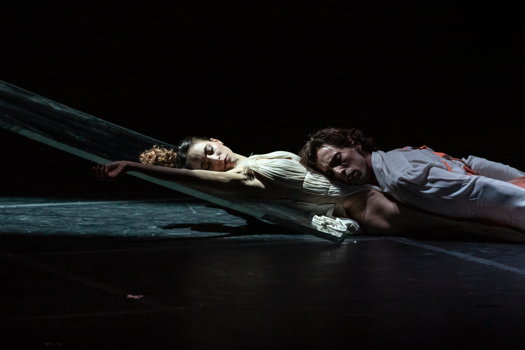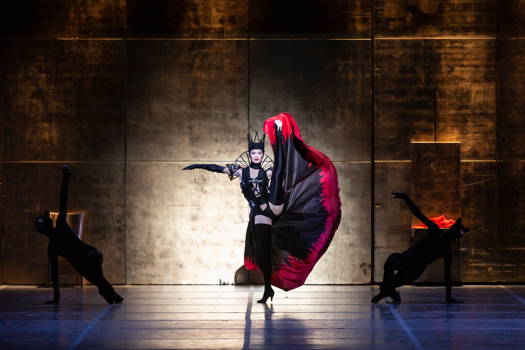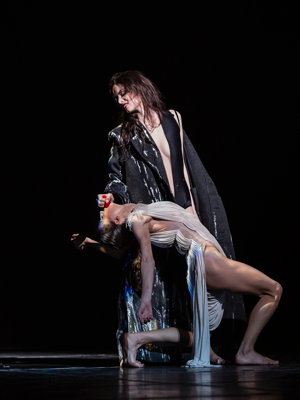 SPONSORED: CD Spotlight. An Encyclopedic Recital - Elizabeth Moak plays Judith Lang Zaimont, heard by the late Howard Smith.
SPONSORED: CD Spotlight. An Encyclopedic Recital - Elizabeth Moak plays Judith Lang Zaimont, heard by the late Howard Smith.
All sponsored features >>
- Bramwell Tovey
- Kazakhstan
- teaching
- Patrice Munsel
- Arpaviva
- Sergio Rendine
- Besançon International Young Conductors' Competition
- Brandon Patrick George
 VIDEO PODCAST: John Dante Prevedini leads a discussion about Classical Music and Artificial Intelligence, including contributions from George Coulouris, Michael Stephen Brown, April Fredrick, Adrian Rumson and David Rain.
VIDEO PODCAST: John Dante Prevedini leads a discussion about Classical Music and Artificial Intelligence, including contributions from George Coulouris, Michael Stephen Brown, April Fredrick, Adrian Rumson and David Rain.
A Superb Mix of Music and Visuals
'Snow White' danced to music by Gustav Mahler,
experienced by GIUSEPPE PENNISI
Can you imagine Snow White, the protagonist of the famous fairytale and of Disney's well-known 1937 animated musical fantasy, dancing to the music of Gustav Mahler? It's hard to believe. Yet, it is the core of the ballet Blanche Neige by the French choreographer of Montenegran descent, Angelin Preljocaj. The ballet had its debut in 2008 at the Lyon Biennial Festival and has since then travelled all over the world. For example, in London it was seen and heard - to much acclaim - at Sadler's Wells in 2013. Eventually, it reached Italy. On 3 May 2019, I was at the opening night of a series of performances at Teatro dell'Opera di Roma. Preljocaj had prepared the Teatro dell'Opera dancers and, as the curtains fell, appeared on-stage to thank the enthusiastic audience that had erupted into eight minutes of standing ovations.
How does Mahler's music fit the tale of the childless Queen who, pricking her finger while sewing one winter, and looking out at the three drops of blood which fell upon the snow, longed for a daughter with skin as white as snow, lips as red as blood and hair as black as ebony? It fits quite well, because like all the Brothers Grimm tales, the plot is not necessarily for children : it is full of ambiguity, gruesome aspects, morbid moments and, at the same time, it has a strong feeling for the beauty of nature and landscape. These are all ingredients of Mahler's music. Preljocaj follows the Grimm Brothers' tale very strictly and adds his own interpretation to the symbols in the plot and in the characters. In interviews and in the program notes, he says that he was helped by an attentive reading of Bruno Bettelheim's La Psychanalyse des contes de fees. In the ballet and in the music, there is plenty of psychoanalysis.
From the dramatic and violent birth of the young princess and the opening ballroom scene, the choreography is outstanding. A pas de deux between two women became a pas de quatre, leading in turn to a pas de six and so on, until there were some twenty-six dancers swirling on stage. A pas de deux between the heroine and her prince, sublimely interpreted by Rebecca Bianchi and Claudio Cocino, began in silence, with Cocino running diagonally across the stage, Bianchi balanced horizontally on one shoulder, before the steps were repeated, this time to one of Mahler's symphonies. In the second part of the ballet, in an impassioned duet, the prince succeeds in awakening the seemingly dead princess, dislodging the poisoned apple stuck in her throat by the intensity of his movements. He kneels before the glass coffin before prostrating himself with grief, and slowly slides her inanimate body towards him. Snow White, as the audience knows, is not dead, but in a trance, and so begins a pas de deux of great intensity.

Rebecca Bianchi as the sleeping Snow White with Claudio Cocino as her prince in 'Snow White' at Teatro dell'Opera di Roma. Photo © 2019 Yasuko Kageyama
The score is atmospheric, creating an environment that captures time and place, and draws one in immediately. The music is constructed from excerpts of various Mahler symphonies - especially Nos 1, 4 and 6 - and tone poems. They are merged skillfully into a score which is not played live by the Teatro dell'Opera orchestra but taped - and used in all performances since 2008. The excerpts are from recordings by Leonard Bernstein (with the New York Philharmonic and the Berliner Philharmoniker), Georg Solti (with the Chicago Symphony Orchestra), Bernard Haitink (Royal Concertgebouw), Pierre Boulez (Chicago Symphony Orchestra and Wiener Philharmiker), Giuseppe Sinopoli (London Philharmonia), Riccardo Chailly (Royal Concertgebouw), Michael Gleten (SWR Sinfonieorchester), Daniel Barenboim (Staatskapelle Berlin) and Simon Rattle (Berlin Philarmoniker). It is amazing how the different tracks, with different conductors and different orchestras express a well-integrated wholeness to provide the proper atmosphere for a fairytale that is in fact a drama.
Jean Paul Gaultier's costumes define the characters clearly, and yet are current and timeless. We recognize the courtiers for who they are, the stepmother for the cruel dominatrix she is, and the miners/dwarves in their steam punk outfits. At the same time, the costuming never gets in the way of the dancing. The princess is, of course, in white attire, but her prince is in a salmon dance suit. The wicked stepmother/witch is clad majestically in black and red.

Virginia Giovanetti as the wicked stepmother/witch in 'Snow White' at Teatro dell'Opera di Roma. Photo © 2019 Yasuko Kageyama
Virginia Giovanetti dominated one of the work's most terrifying and theatrical moments, forcing the poisoned apple into her rival's mouth while the latter's seven small protectors were out working the gold mines.

Virginia Giovanetti as the wicked stepmother/witch forces the poisoned apple into the mouth of Snow White (danced by Rebecca Bianchi), in 'Snow White' at Teatro dell'Opera di Roma. Photo © 2019 Yasuko Kageyama
The ballet rises dramatically to a peak when the unearthly figure of the long-dead Queen flies down from the netherworld to gather her daughter up in her arms, only to return through the air to lay the princess' quiescent body gently back down to earth; it was not yet time.
Tasteful sets by Thierry Leproust sweep the audience into a magical land, from the evocative beauty of the sombre forest, leading to the glittering mountain of enchantment worked by the seven dwarfs, who came down from the heights.
A masterly production with a superb mix of music and visuals.
Copyright © 5 May 2019
Giuseppe Pennisi,
Rome, Italy



